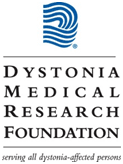On Friday, January 24, Billy gave a very special concert. It was the first time he had performed simultaneously to a live audience and an audience around the world. The concert, “Streaming for Dystonia,” was sponsored by the Dystonia Medical Research Foundation (DMRF) as part of a crusade to increase awareness of dystonia and to help raise funds for medical research. “Somebody in your circle of friends has dystonia,” said Billy at the concert. “It comes in so many forms, from someone suffering from writers’ cramp to someone whose neck muscles spasm so that they can’t straighten up to someone whose voice has become progressively hoarse.” These are all symptoms of dystonia, which makes it’s difficult to recognize,” he explained.
Billy considers himself fortunate to have found a way around his dystonia. He explained to the audience the way he now plays his guitar, with his left hand, and how he had to learn to fail his way to success. “As with dystonia, you can’t be afraid,” said Billy. For three years, Billy had suffered from the symptoms without it being properly diagnosed. During that time he lost his home, marriage, recording contracts and his music. “I’m here to help people find a way out of the trap that is dystonia,” said Billy. “I’m lucky because I can still do something I love to do.”
Billy is passionate about advancing the entire field of neurosciences. “The power of a chronic condition like dystonia, Parkinson’s or epilepsy to beat us down is really tremendous,” he said. Billy finds it an amazing coincidence that DMRF began its research into dystonia in 1976, the same year that he started playing guitar. “The worst thing that ever happened to me has unfolded to be the best thing that ever happened. To have this opportunity to play my music with meaning and purpose is truly a blessing. Thank you to all who turned out and tuned in to build awareness of dystonia!”
For more information about DMRF or to make a contribution, visit www.dystonia-foundation.org.
Written by Linda Ruhland
-

-
Streaming for Dystonia (photo credit: Chuck Plante)
-

-
Streaming for Dystonia (photo credit: Chuck Plante)
-

-
Dystonia Support Meeting
-

-
Dystonia Support Meeting













